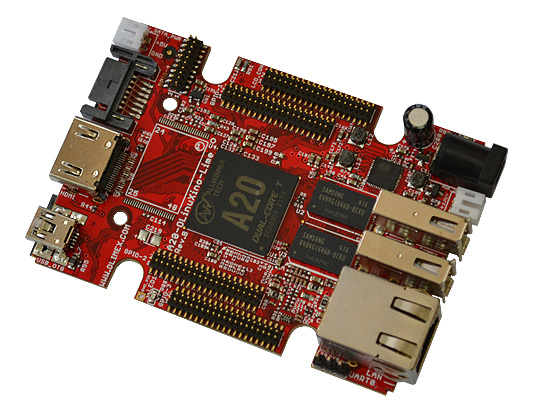Raymii.org

Quis custodiet ipsos custodes?Home | About | All pages | Cluster Status | RSS Feed
Olimex OlinuXino A20 LIME2 Minimal Debian 7 Image
Published: 28-01-2015 | Author: Remy van Elst | Text only version of this article
❗ This post is over ten years old. It may no longer be up to date. Opinions may have changed.
Table of Contents

I have an Olimex A10 LIME board for which I've made a minimal image, see this page for details. It is a very awesome and powerfull ARM dev board with open source hardware. I like it so much that I decided to also get the A20.
The Olimex A20-LIME2 is the big brother of the A10. The Olimex Olinuxino A20 LIME2, an open source hardware ARM (Allwinner A20) dual core based dev board with 160 GPIO's, 1,2 GHz/1 GB RAM, 2 USB 2.0 ports, 1 esata port, 1 hdmi port, USB-OTG, 1 gbit lan (not via the usb bus) and more of those nice features. The price is even more awesome, the device costs 45 euro's, add 5 euro's and you have yourself a nice black case. It consumes very little power, combined with all the features a perfect dev / tinkerboard.
Recently I removed all Google Ads from this site due to their invasive tracking, as well as Google Analytics. Please, if you found this content useful, consider a small donation using any of the options below. It means the world to me if you show your appreciation and you'll help pay the server costs:
GitHub Sponsorship
PCBWay referral link (You get $5, I get $20 after you've placed an order)
Digital Ocea referral link ($200 credit for 60 days. Spend $25 after your credit expires and I'll get $25!)
Olimex sponsored a board for me to create the image, I would like to thank them very much for them.
The difference with the A10-LIME is the dual core ARM processor, 1 GB of ram instead of 512 and gigabit networking.
Sadly, the default Debian 7 image suplied by Olimex is bloated and huge. Perfect for the general tinkerer, has a Desktop Environment and a lot of dev tools and support for everything. Not perfect for me, I want a small minimal base to start and add up on that only what I need. This image takes up about 200 MB of space and uses only around 15 MB of RAM idle.
I took this image and stripped everything out of it, leaving only the bare minimum. Basically it only runs SSH and allows you to install the tools you need to build your project, without any other cruft.
It is also more optimized to run off flash storage, by default it has no logging, no locatedb updates, noatime mount option, this all reducing writes to the SD card.
The main features / differences from the Olimex provided Debian image (Debian 7 with kernel 3.4.90):
- Removed
olimexuser - Removed all graphical software (x11/desktop etc) (
apt-get purge --auto-remove 'libx11-.*') - Removed crtmpserver
- Removed Apache
- Removed development packages like gcc, perl and python-dev
- Removed a lot of kernel modules for things like WiMax, wireless, iscsi etc.
- Removed other packages like audio and video codecs
- Removed compiled ffmpeg
- Removed kernel modules for media and wireless
- Removed all locales and documentation
- Replaced openssh by Dropbear (port 22 default)
- Username/password the same, 'root/olimex'
- Getty terminals off, only ssh.
- DHCP enabled on eth0.
The kernel itself is still 3.4, the Debian version is 7 for armhf.
Download
You can download the image from here:
- HTTPS: tar.gz, click here
- TORRENT: .torrent, click here
- MD5SUM: e1987a80584f669ffd820f012f293b85
- SHA256: 3d0eaf6c6315d7c03795f73ff616bb0327f3a246e13f648ff6ab43d990e6f447
Feel free to mirror it wherever you want. If you like it or use it, you might consider sending me a nice email. Or, if this image helped you and you want to support me AND get $10 Digital Ocean credit (2 months free), use this link to order: https://www.digitalocean.com/?refcode=7435ae6b8212
Instructions
Download the image:
wget https://2162bb74000a471eb2839a7f1648771a.objectstore.eu/olimex/a20_debian7_minimal_raymii.img.tar.gz
Extract it:
tar -xf a20_debian7_minimal_raymii.img.tar.gz
Verify the md5 sum:
md5 a20_debian7_minimal_raymii.img
sha256sum a20_debian7_minimal_raymii.img
If it is correct, continue. If it is not correct, retry the download.
Plug in your microSD card and use dmesg to see which device it is.
Please note that this image is supposed to be on the MicroSD card. I don't know if and how it works on the eMMC internal flash.
Write the image to the microSD card:
dd if=a20_debian7_minimal_raymii.img of=/dev/mmcblk0
Afterwards, use a tool like (c)fdisk, parted or gparted to enlarge the second partition. It is only 500 MB, which is to small to use most of the time.
Plug the microSD card back in and boot the Olimex. It receives an IP address via
DHCP. Check your router, the serial console or use nmap to find it. Log in as
root with the password olimex.
If you want to install software, please apt-get update first, since the apt-
lists are removed to save +100 MB.
Enjoy!
Tags: a20 , allwinner , arm , articles , debian , gpio , minimal , olimex , olinuxino , raspberry-pi